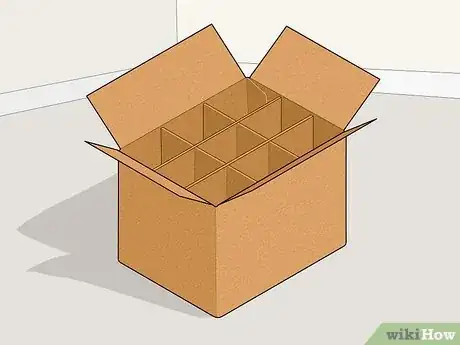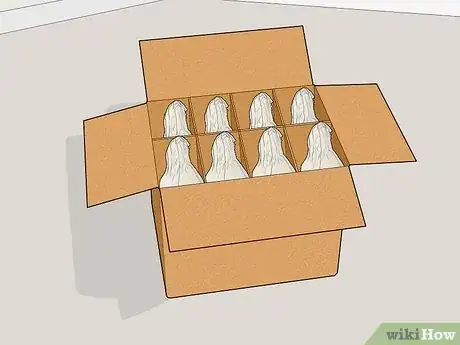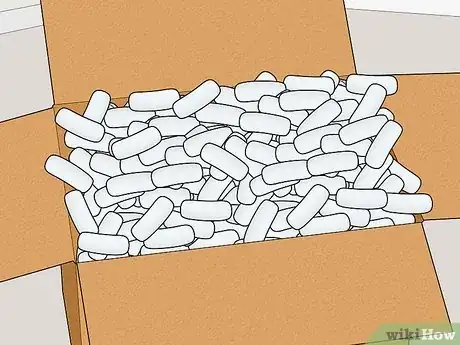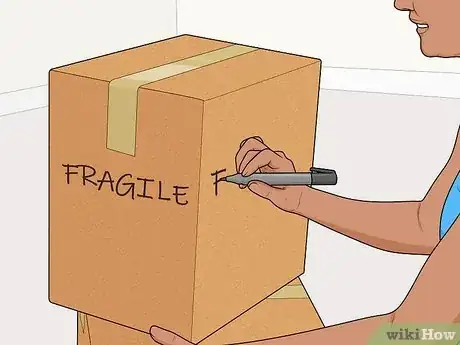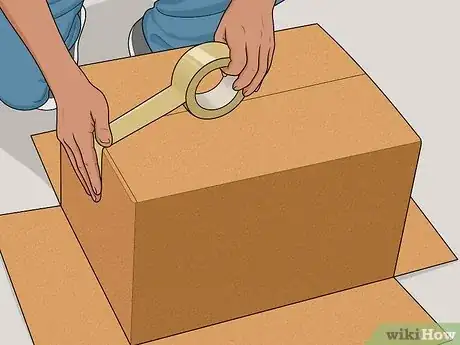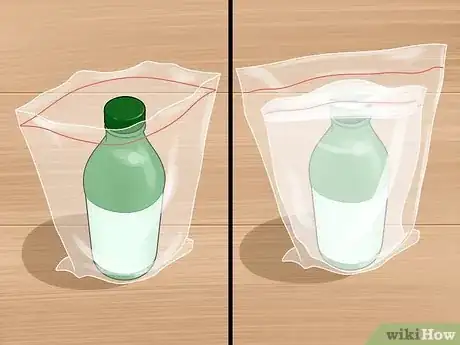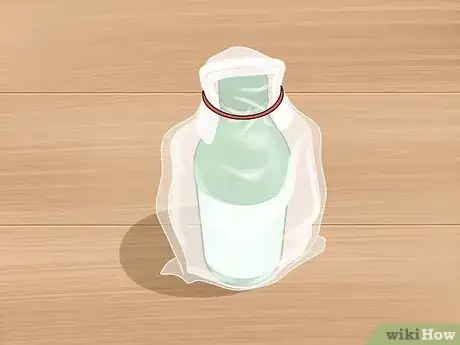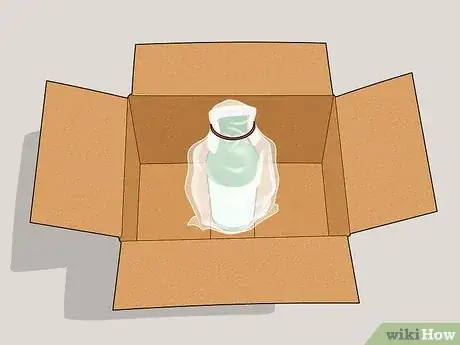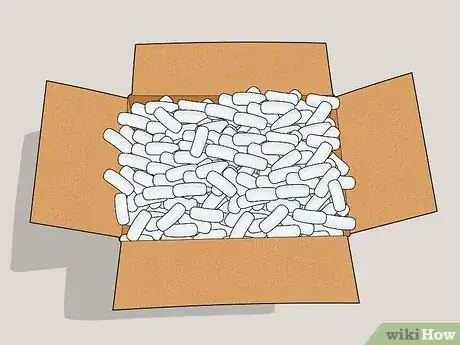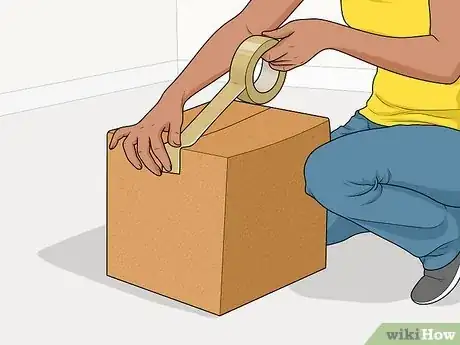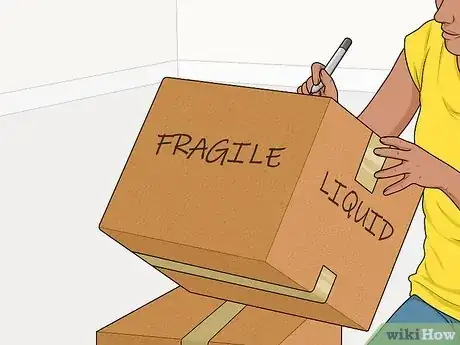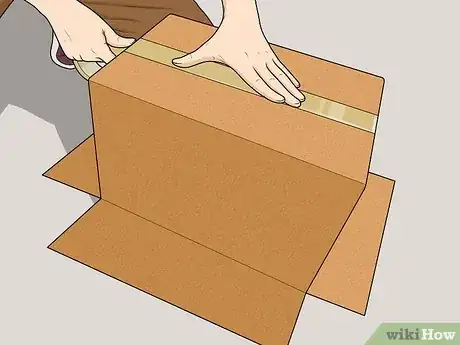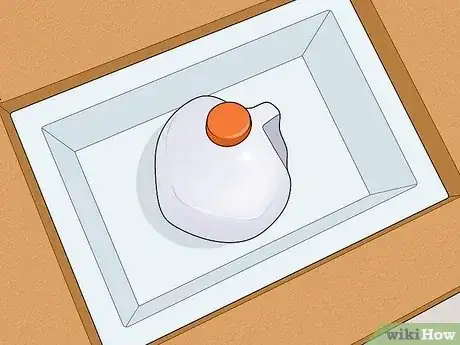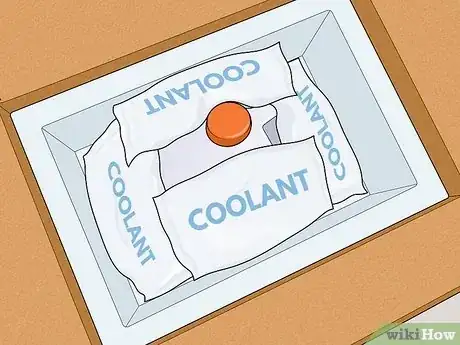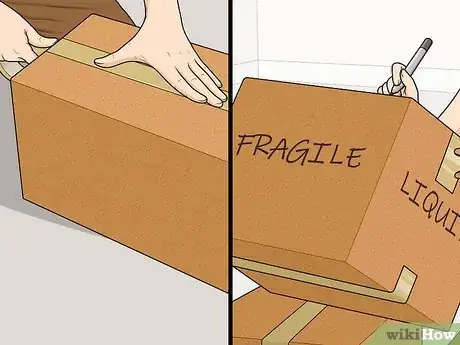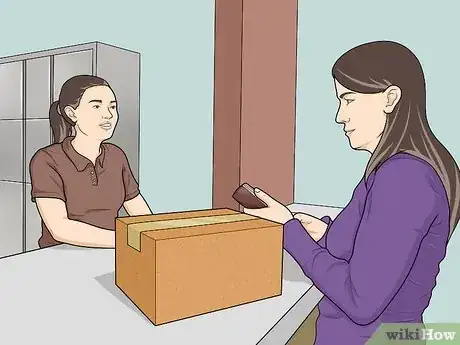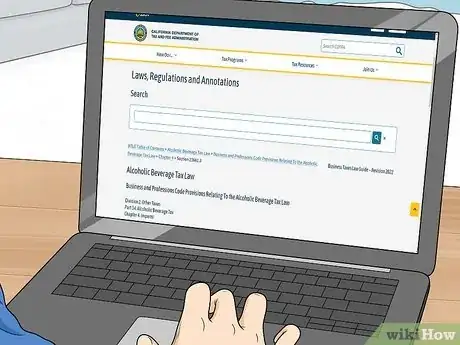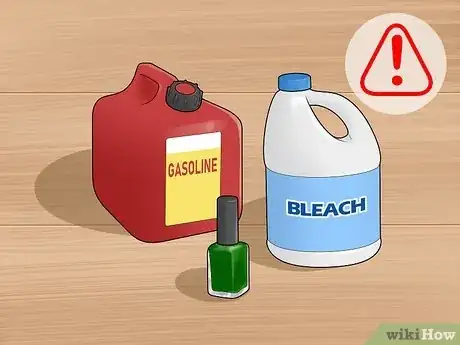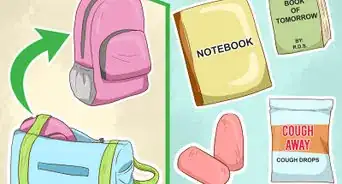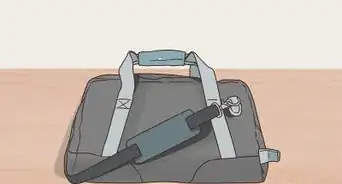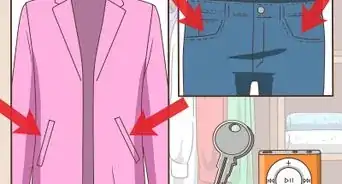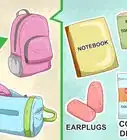This article was co-authored by Marty Stevens-Heebner, SMM-C, CPO®. Marty Stevens-Heebner is a Certified Professional Organizer (CPO) and Founder of Clear Home Solutions, a home organizing and senior moving management company based in southern California. Marty is the first Certified Senior Move Manager (SMM-C) in the United States and is a Certified Aging in Place Specialist (CAPS) through the National Association of Home Builders. She is the President-Elect and is on the board of directors of the National Association for Senior Move Managers, a member of the National Association of Professional Organizers, and has been acknowledged as a Hoarding Specialist and ADHD Specialist through the Institute for Challenging Disorganization.
There are 7 references cited in this article, which can be found at the bottom of the page.
This article has been viewed 50,704 times.
Shipping liquids may seem confusing, but all it takes is some careful packing. We can help you get your package ready to mail so it arrives safe and sound!
Steps
Filling a Cardboard Box
-
1Assemble and tape shut the bottom of a corrugated box. Pull apart the box’s sides to separate them. Fold the flaps on both ends to get the box into shape. Then choose 1 end to seal with packing tape. Tape along the seams to ready the box for packing.
- For shipping, use corrugated cardboard boxes. These boxes are double-walled, so they’re stronger than regular boxes.
-
2Set a cardboard tray inside the box for easier packing. The tray is similar to an egg carton, dividing the box into cells that hold containers in place. It’s a useful option when you plan on sending multiple items. They can be purchased from moving and shipping companies, but many liquor stores can give you some for free if you ask nicely.[1]
- Foam trays are another option. These trays come in various sizes to hold all sorts of containers.
- If you are using a specialty wine box, the tray will already be in place.
Advertisement -
3Wrap the container of liquid in paper. Wrapping paper or newspaper is usually enough protection with a tray. Roll the paper around each container as tightly as possible. To be safe, you can also wrap the containers in bubble wrap.[2]
- When shipping multiple containers, wrap each one individually.
- Use rubber bands or packing tape as needed to hold the wrapping in place.
-
4Place the container of liquid into the box. If you have a tray, this part is easy. Slide the container into the tray’s cell, squeezing the wrapping as needed to fit it. Keep the lid or cap end pointed upwards. Double-check that the container is wedged in place with its cap on securely. Repeat this with any other containers sent in the same package.
- If you choose not to use a tray, lay the container in the center of the box. Keep it away from the sides as much as possible.
-
5Fill the extra space around the container with filler material. Stuff the packing peanuts, bubble wrap, or air bags into the package as needed.[3] Use them to eliminate any leftover space, such as between the container and the wall. Also add cushioning above the container as needed.
- The extra padding can make the difference between a broken container and successful shipping.
-
6Tape the box shut with packing tape. Fold the box’s top flaps together. Tape along all the seams. Attempt to lift the flaps to check how well they are taped down. Cover over any loose spots with additional layers of tape to ensure your package doesn’t open up in the delivery person’s hands![4]
-
7Label the box to show it contains liquid. Find a black permanent marker. On the top side of the box, write “Liquid” and “Fragile” in capital letters. In fact, write it several times all over the box to make your point. Then, take the box to the shipping company. Have them print out a label and place it on the top of the box.[5]
- Labeling the contents as liquid or fragile does not guarantee that the box will arrive in 1 piece, but it may alert a carrier about to handle the package roughly.
Using Watertight Bags
-
1Assemble a corrugated box. Shape the box by folding the flaps as you normally would. Use packing tape to tape down the flaps on 1 side -- this will be the bottom of the box. Double-check to ensure that there are no weak spots on this end.
-
2Place the container of liquid in 2 watertight bags. Set the contained liquid in 1 of the bags. Fit it all the way into the bag so it doesn't stick out, then stuff the bag into the second bag. This ensures the package gets to its destination without leaking, which the carriers appreciate.[6]
-
3Tie the bags shut to seal them. Take the ends of both bags and twist them together. Fold the twisted part down over itself, then slip a rubber band over it. The rubber band should hold the ends of the bag tightly together.[7]
- Watertight bags are basically resealable sandwich bags. You can get them anywhere, but the grocery stores and office supply stores often stock them.
-
4Place the bagged liquid into the cardboard box. Nestle the liquid right in the bottom center of the box so that it will have plenty of support on all sides. You may want to put a layer of packing material on the bottom of the box, too.
-
5Fill the rest of the space around the liquid with packing material. Stuff in the packing material as needed to fill the rest of the box. Fit it between the outside of the bag and the box’s edges.[8] It’s a good idea to place some on top of the bag in case someone sets another box on top of yours.
-
6Fold the box flaps together and seal them shut with packing tape. Get the flaps on the box’s underside, too. Tape over any seams that appear loose. Once the box feels secure, you’re ready to label it and bring it to the shipping company.[9]
-
7Write “Liquid” or “Fragile” in large, visible letters all over the box. Then hand the box to the shipping company and have them print out a label with both the recipient’s and your name and address.[10]
Shipping Perishables
-
1Assemble the corrugated box. As usual, transform flat cardboard into a box. Fold down all the flaps to finish shaping it. Then tape down the bottom end, sealing any seams.
-
2Put an insulated Styrofoam container inside the box. You can purchase this insulated container from a shipping company or office supply store. It should be slightly smaller than the box so that it fits tightly inside of it. It serves as both cushioning and absorbent material.[11]
-
3Place the liquid in a second container. Take the container holding the liquid and set it inside a larger container. This container has to be waterproof with a lid that fits on tightly. Make sure there are no cracks in it and that it has a little extra space for coolant packs. Set the containers inside the box.[12]
- Another option is to use watertight plastic bags. Either one works well, unless the shipping company has special rules on the issue. Ask them if you’re unsure.
-
4Pack coolants around the container. Coolant packs can also be obtained from the shipping company or the grocery store. Fit them between the Styrofoam container and the liquid container. Lay a coolant under the container, then place 3 or 4 more between the container’s sides and the Styrofoam.[13]
- Coolant packs can also be purchased from the shipping company or an office supply store.
-
5Tape the box shut and label it. Fold the box’s remaining flaps, then tape them down with packing tape. Seal the box by covering any other seams. Print off a shipping label and stick it to the box’s top. Also write “Fragile,” “Liquid,” or “Perishable” over the box to encourage others to handle it gently.
Following Shipping Rules
-
1Speak to a shipping company about sending liquids. Anytime you feel confused about how to pack the liquids, talk to a representative of the shipping company. They will be happy to guide you on the requirements and recommendations, as well as tell you what you can and can’t ship.
- Companies like UPS and FedEx will ship liquids. Post offices generally don’t accept these packages.
-
2Check your government’s rules when shipping alcohol. The rules differ from region to region. The government may require you to have a license to ship. Shipping companies have this license, so you may be able to use their services, but only when shipping to select locations.
- It’s usually acceptable to ship a few small bottles to a friend. You can’t ship large cases of alcohol for sale without a license.
-
3Avoid sending dangerous liquids. What counts as dangerous is also defined by your local government. This includes flammable and poisonous liquids, including gasoline, bleach, and even nail polish. If it has the potential to cause harm to a carrier, you can’t legally send it. Ask the shipping company for more clarification.[14]
- The liquids have to be doubly sealed, too. Don’t try to send a product you have already opened.
Expert Q&A
-
QuestionHow do I safely pack a liquid to ship?
 Marty Stevens-Heebner, SMM-C, CPO®Marty Stevens-Heebner is a Certified Professional Organizer (CPO) and Founder of Clear Home Solutions, a home organizing and senior moving management company based in southern California. Marty is the first Certified Senior Move Manager (SMM-C) in the United States and is a Certified Aging in Place Specialist (CAPS) through the National Association of Home Builders. She is the President-Elect and is on the board of directors of the National Association for Senior Move Managers, a member of the National Association of Professional Organizers, and has been acknowledged as a Hoarding Specialist and ADHD Specialist through the Institute for Challenging Disorganization.
Marty Stevens-Heebner, SMM-C, CPO®Marty Stevens-Heebner is a Certified Professional Organizer (CPO) and Founder of Clear Home Solutions, a home organizing and senior moving management company based in southern California. Marty is the first Certified Senior Move Manager (SMM-C) in the United States and is a Certified Aging in Place Specialist (CAPS) through the National Association of Home Builders. She is the President-Elect and is on the board of directors of the National Association for Senior Move Managers, a member of the National Association of Professional Organizers, and has been acknowledged as a Hoarding Specialist and ADHD Specialist through the Institute for Challenging Disorganization.
Certified Professional Organizer & Senior Move Manager Certified Professional Organizer & Senior Move ManagerExpert AnswerMake sure you put padding material inside of the box to fill any excess space. This prevents anything from moving around and breaking.
Certified Professional Organizer & Senior Move ManagerExpert AnswerMake sure you put padding material inside of the box to fill any excess space. This prevents anything from moving around and breaking.
Warnings
- Some liquids cannot be shipped by law. Consult your government’s laws and speak to the shipping company to avoid potential legal issues.⧼thumbs_response⧽
Things You’ll Need
Filling a Cardboard Box
- Corrugated cardboard box
- Box tray
- Bubble wrap or other filler material
- Packing tape
- Box label
Using Watertight Bags
- Corrugated cardboard box
- 2 watertight bags
- Rubber band
- Packing material
- Packing tape
- Box label
Shipping Perishables
- Corrugated cardboard box
- 2 watertight bags or containers
- Coolant packs
- Packing material
- Packing tape
- Box label
References
- ↑ https://support.shippingeasy.com/hc/en-us/articles/203981689-Shipping-alcohol-with-USPS-UPS-and-FedEx
- ↑ http://thebeerexchange.io/how-to-package-and-ship-beer.html
- ↑ Marty Stevens-Heebner, SMM-C, CPO®. Certified Professional Organizer & Senior Move Manager. Expert Interview. 6 February 2020.
- ↑ https://www.ups.com/us/en/services/individual-shipper/preparing-to-ship.page
- ↑ https://bizfluent.com/how-7661854-pack-soda-bottles-shipping.html
- ↑ https://images.fedex.com/downloads/shared/packagingtips/howtopack.pdf
- ↑ https://images.fedex.com/downloads/shared/packagingtips/howtopack.pdf
- ↑ Marty Stevens-Heebner, SMM-C, CPO®. Certified Professional Organizer & Senior Move Manager. Expert Interview. 6 February 2020.
- ↑ https://www.ups.com/us/en/services/individual-shipper/preparing-to-ship.page
- ↑ https://bizfluent.com/how-7661854-pack-soda-bottles-shipping.html
- ↑ https://images.fedex.com/downloads/shared/packagingtips/howtopack.pdf
- ↑ https://images.fedex.com/downloads/shared/packagingtips/howtopack.pdf
- ↑ https://images.fedex.com/downloads/shared/packagingtips/howtopack.pdf
- ↑ https://www.usps.com/ship/shipping-restrictions.htm

